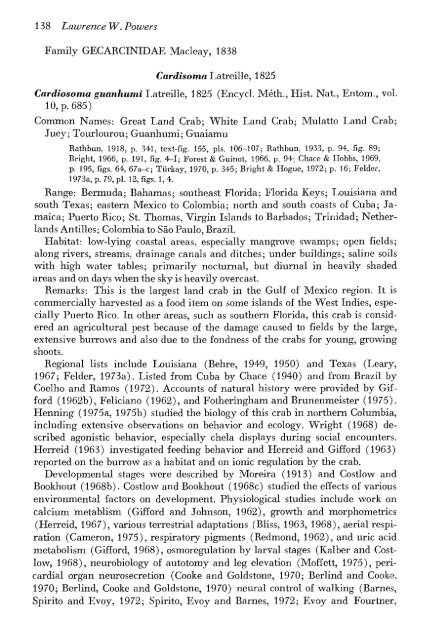You also want an ePaper? Increase the reach of your titles
YUMPU automatically turns print PDFs into web optimized ePapers that Google loves.
138 Lawrence W. Powers<br />
Family GECARCINIDAE Macleay, 1838<br />
Cardisoma Latreille, 1825<br />
Cardiosoma guanhunii Latreille, 1825 (Encycl. Meth., Hist. Nat., Entom., vol.<br />
10, p. 685)<br />
Common Names: Great Land Crab; White Land Crab; Mulatto Land Crab;<br />
Juej'-; Tourlourou; Guanhumi; Guaiamu<br />
Rathbun, 1918, p. 341, text-fig. 155, pis. 106-107; Rathbun, 1933, p. 94, fig. 89;<br />
Hright, 1966, p. 191, fig. 4-1; Forest & Guinot, 1966, p. 94; Chace & Hobbs, 1969,<br />
p. 195, figs. 64, 67a-c; Tiirkay, 1970, p. 345; Rright & Hogue, 1972; p. 16; Felder,<br />
1973a, p. 79, pi. 12, figs. 1,4.<br />
Range: Bermuda; Bahamas; southeast Florida; Florida Keys; Louisiana and<br />
south Texas; eastern Mexico to Colombia; north and south coasts of Cuba; Jamaica;<br />
Puerto Rico; St. Thomas, Virgin Islands to Barbados; Trinidad; Netherlands<br />
Antilles; Colombia to Sao Paulo, Brazil.<br />
Habitat: low-lying coastal areas, especially mangrove swamps; open fields;<br />
along rivers, streams, drainage canals and ditches; under buildings; saline soils<br />
with high water tables; primarily nocturnal, but diurnal in heavily shaded<br />
areas and on days when the sky is heavily overcast.<br />
Remarks: This is the largest land crab in the Gulf of Mexico region. It is<br />
commercially harvested as a food item on some islands of the West Indies, especially<br />
Puerto Rico. In other areas, such as southern Florida, this crab is considered<br />
an agricultural pest because of the damage caused to fields by the large,<br />
extensive burrows and also due to the fondness of the crabs for young, growing<br />
shoots.<br />
Regional lists include Louisiana (Behre, 1949, 1950) and Texas (Leary,<br />
1967; Felder, 1973a). Listed from Cuba by Chace (1940) and from Brazil by<br />
Coelho and Ramos (1972). Accounts of natural history were provided by Gifford<br />
(1962b), Feliciano (1962), and Folheringham and Brunenmeister (1975).<br />
Henning (1975a, 1975b) studied the biology of this crab in northern Columbia,<br />
including extensive observations on behavior and ecology. Wright (1968) described<br />
agonistic behavior, especially chela displays during social encounters.<br />
Herreid (1963) investigated feeding behavior and Herreid and Gifford (1963)<br />
reported on the burrow as a habitat and on ionic regulation by the crab.<br />
Developmental stages were described by Moreira (1913) and Costlow and<br />
Bookhout (1968b). Costlow and Bookhout (1968c) studied the effects of various<br />
environmental factors on development. Physiological studies include work on<br />
calcium metablism (Gifford and Johnson, 1962), growth and morphometries<br />
(Herreid, 1967), various terrestrial adaptations (Bliss, 1963, 1968), aerial respiration<br />
(Cameron, 1975), respiratory pigments (Redmond, 1962), and uric acid<br />
metabolism (Gifford, 1968), osmoregulation by larval stages (Kalber and Costlow,<br />
1968), neurobiology of autotomy and leg elevation (Moffett, 1975), pericardial<br />
organ neurosecretion (Cooke and Goldstone, 1970; Berlind and Cooke,<br />
1970; Berlind, Cooke and Goldstone, 1970) neural control of walking (Barnes,<br />
Spirito and Evoy, 1972; Spirito, Evoy and Barnes, 1972; Evoy and Fourtner,

















